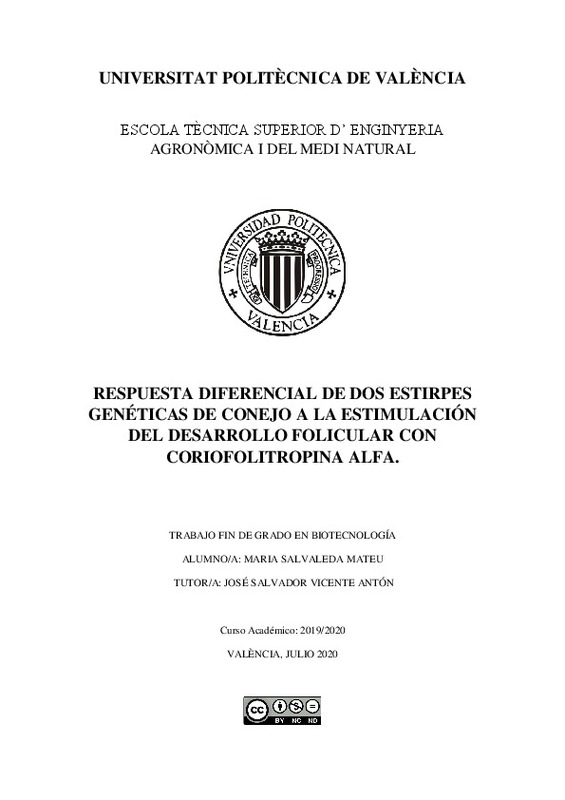|
Resumen:
|
[ES] La tecnología reproductiva ha permitido solventar diferentes problemas de infertilidad humana mientras en otros mamíferos ha facilitado la conservación, manipulación, producción y difusión de genotipos de interés tanto ...[+]
[ES] La tecnología reproductiva ha permitido solventar diferentes problemas de infertilidad humana mientras en otros mamíferos ha facilitado la conservación, manipulación, producción y difusión de genotipos de interés tanto en producción animal como en modelos animales para enfermedades, bio-reactores o farmacológicos. Siendo la superovulación una de las principales tecnologías, se utiliza con la intención de obtener un mayor número de embriones y óvulos. En el conejo, como en otros mamíferos de interés, es habitual aplicar productos de estimulación como la eCG, hCG, hMG, FSH de origen hipofisario y recientemente FSH recombinantes como la Coriofolitropina alfa (rhFSH-CTP), que corresponde a una FSH recombinante de larga duración. A pesar de las ventajas de esta hormona, al igual que el resto de tratamientos de superovulación, su respuesta ovulatoria no es uniforme, sino que hay ciertos parámetros como la edad, la nutrición y el sobrepeso, el ambiente o el genotipo que pueden hacer que varié entre diferentes individuos.
El objetivo de este estudio fue evaluar la eficiencia de la rhFSH-CTP+hCG para obtener embriones sobre dos líneas genéticas de conejo con características diferenciales en términos de parámetros de crecimiento y reproductivos. La primera de ellas fue seleccionada por crecimiento y tiene problemas reproductivos, mientras que la segunda se escogió por su prolificidad y muestra unos excelentes índices reproductivos. Conejas nulíparas de ambas líneas fueron tratadas con 3ug de rhFSH-CTP suplementado con 7,5 IU de hCG. Fue estudiada su respuesta en términos de tasa de ovulación, eficiencia, número y calidad de los embriones recuperados y fue evaluado el efecto del tratamiento sobre la viabilidad postransferencia de los embriones obtenidos frente a embriones de conejas controles no tratadas en ambas líneas.
Los resultados obtenidos sugieren que el tratamiento rhFSH-CTP+hCG incrementa tanto la tasa de ovulación, hasta 57,8 frente 11,5 control, como el número de embriones normales recuperados por hembra (37,1 vs 9,3 control). No obstante, se observaron diferencias significativas entre las líneas para el número, la eficiencia total y el porcentaje de normalidad de los embriones recuperados, pudiendo establecer una relación negativa de la rhFSH-CTP con el genotipo de la línea R. Además, pudo comprobarse que los embriones seleccionados conforme al criterio de calidad morfológico presentaban la misma viabilidad postransferencia con independencia del tratamiento y de la línea genética. En general el 74,7% de los embriones transferidos implantaron y el 62,2% llegaron a nacer. En conclusión, el tratamiento de superovulación con coriofoltropina alfa permitió incrementar por 4 el número de embriones catalogados como normales o de excelente calidad atendiendo a criterios morfológicos. Estos embriones, una vez transferidos, alcanzaron porcentajes de viabilidad al parto similar a los embriones de conejas no superovuladas. No obstante, la línea genética de origen de los embriones si tuvo efecto sobre el porcentaje de embriones con excelente calidad morfológica, mostrando que el genotipo de la línea R interacciona negativamente con el tratamiento de superovulación.
[-]
[EN] Reproductive technology has solved different human infertility problems whereas in other mammals has facilitated genotype interest conservation, manipulation, production and diffusion in animal production and animal ...[+]
[EN] Reproductive technology has solved different human infertility problems whereas in other mammals has facilitated genotype interest conservation, manipulation, production and diffusion in animal production and animal model for illnesses, bio-reactors, pharmacological model. Superovulation is known as one of the main reproductive technologies and it is used for obtaining a higher number of embryos and oocytes. Applying stimulation products to rabbits, or other mammals of interest, like eCG, hCG, hMG, or pituitary FSH is a common practice. Recently, recombinant FSH with a larger duration of action named Coriofolitropina alfa (rhFSH-CTP) is being commercialised. Despite the advantages of this hormone, like the rest of superovulation treatments, the response is not uniform. It depends on other parameters like age, nutrition and overweight, environment, or genotype that can induce different responses among individuals
This study aimed to evaluate the efficiency of rhFSH-CTP to obtain embryos on two genetic lines with different characteristics in terms of growth and reproductive parameters. The first one was selected because of its fast growth rate and has reproductive problems, whereas the second one was chosen due to its prolificity and shows excellent reproductive indices. Nulliparous rabbits of both lines were treated with 3ug of rhFSH-CTP supplemented with 7,5IU of hCG. It was studied its responsiveness to the treatment based on ovulation rate, efficiency, number and quality of recovered embryos, and evaluated the effect of the treatment on recovered embryo postransference viability versus untreated control rabbit embryos from both lines.
The results showed that the treatment with rhFSH-CTP increases ovulation rate, from 11.5 control to 57.8, and the number of normal embryos recovered by female (37,1 vs 9,3 control). Nevertheless, significant differences were observed between the lines for the normal embryo number, efficiency, and percentage. Therefore, establishing a negative relation of rhFSH-CTP with R line genotype. Furthermore, the selected embryos according to the morphological quality criteria showed the same viability independently of the genetic line or the treatment received. Generally, 74.7% of the transferred embryo were able to implant successfully and 62.2% were born. In conclusion, superovulation treatment with corifolitropina alfa increased four times the number of embryos catalogued as normal or of excellent quality according to the morphological criteria. Once transferred, these embryos showed similar viability percentages compared with control embryos. However, the genetic line of the embryo affected the excellent morphological quality embryo percentage, showing that the genotype of the R line interacts negatively with the superovulation treatment.
[-]
|







